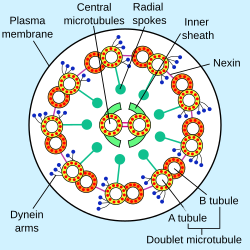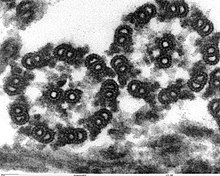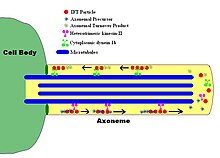
Back خيط محوري Arabic Aksonema BS Axonema Catalan Axonema Czech Axonem German Axonema Spanish Axonema Basque ساقه مژکی Persian Axonème French Axonema Galician
This article includes a list of general references, but it lacks sufficient corresponding inline citations. (May 2009) |
| Axoneme | |
|---|---|
 Eukaryotic flagellum. 1-axoneme, 2-cell membrane, 3-IFT (intraflagellar transport), 4-basal body, 5-cross section of flagellum, 6-triplets of microtubules of basal body. | |
 Cross section of an axoneme in a flagellum | |
| Identifiers | |
| MeSH | D054468 |
| TH | H1.00.01.1.01017 |
| Anatomical terminology | |


In molecular biology, an axoneme, also called an axial filament, is the microtubule-based cytoskeletal structure that forms the core of a cilium or flagellum.[1][2] Cilia and flagella are found on many cells, organisms, and microorganisms, to provide motility. The axoneme serves as the "skeleton" of these organelles, both giving support to the structure and, in some cases, the ability to bend. Though distinctions of function and length may be made between cilia and flagella, the internal structure of the axoneme is common to both.
- ^ "axial filament". TheFreeDictionary.com. Retrieved 9 May 2021.
- ^ Porter ME, Sale WS (November 2000). "The 9 + 2 axoneme anchors multiple inner arm dyneins and a network of kinases and phosphatases that control motility". The Journal of Cell Biology. 151 (5): F37-42. doi:10.1083/jcb.151.5.F37. PMC 2174360. PMID 11086017.
© MMXXIII Rich X Search. We shall prevail. All rights reserved. Rich X Search